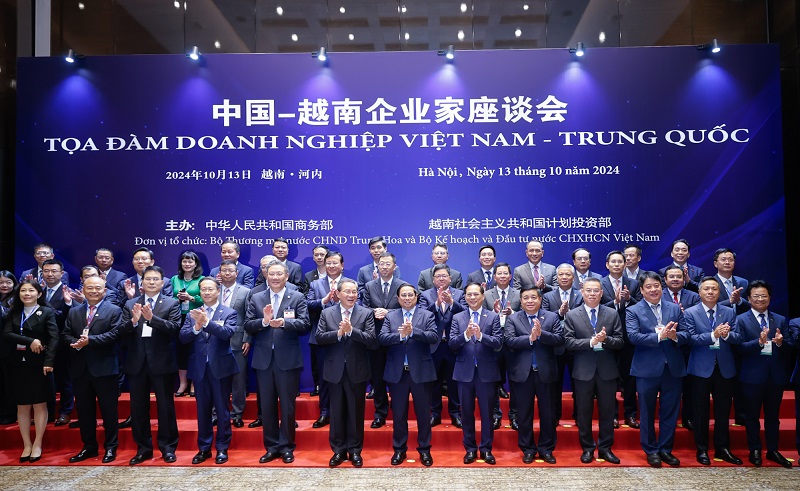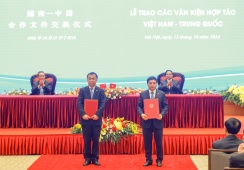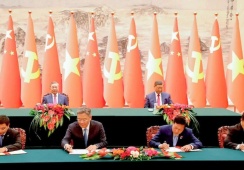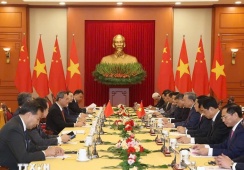
Chinese Premier Li Qiang and a high-ranking Chinese delegation today (October 14) departed from Hanoi for Beijing after a three-day official visit to Vietnam at the invitation of Prime Minister Pham Minh Chinh.
| Deputy Prime Minister and Minister of Foreign Affairs Bui Thanh Son (first, left), Deputy Minister of Foreign Affairs Nguyen Minh Vu (second, left), and other officials bid farewell to Premier Li Qiang (R) at Noi Bai International Airport. Photo: Vietnam News Agency |
This was Li’s first visit to Vietnam as the Chinese Premier, marking the first Chinese Premier’s official visit to Vietnam in 11 years.
During the visit, the Chinese Premier had meetings with General Secretary and State President of Vietnam To Lam, Chairman of the National Assembly Tran Thanh Man, Prime Minister Pham Minh Chinh, visited the Ho Chi Minh Mausoleum and paid tribute to President Ho Chi Minh, co-chaired the Vietnam-China Business Forum, and visited a fair displaying Vietnamese farm products exported to China.
At the meeting, Vietnamese leaders welcomed Premier Li’s visit and hoped that the visit would spur and propel the comprehensive, friendly relations between Vietnam and China. They expected that the Vietnam-China relations would progress further and have positive impacts on the growth of the region and the world.
With respect, friendliness and openness, the leaders of the two nations informed each other of the developments of Vietnam and China. They agreed to come up with solutions and directions to better implement the principle of “six major goals”, and build the Vietnam-China community with a shared future, which were consented by top national leaders.
On the occasion, the two Government leaders of Vietnam and China saw 10 agreements signed and exchanged to enhance relations in transportation, customs, social affairs, education and training, agriculture, journalism and communication, and banking.
Vietnam's Prime Minister promises good conditions for Chinese investors
The Vietnamese Government is committed to supporting and creating favorable conditions for foreign investors, especially Chinese enterprises, to operate in the domestic market, Prime Minister Pham Minh Chinh said at the Vietnam-China Business Forum on October 13.
According to Prime Minister Chinh, the Vietnamese Government guarantees that foreign-invested economic sectors will remain a vital part of Vietnam's economy. It is ready to facilitate the long-term, stable, and sustainable development of these sectors, ensuring fair competition and cooperation with other economic areas.
Foreign investors will have their legitimate rights and interests protected, benefiting from political stability, public order, and consistent investment policies. The Government is committed to timely policy adjustments in response to positive developments, favoring investors and businesses, while continuously improving the business environment to provide peace of mind for long-term operations in Vietnam.
The Government will also work on improving governance and infrastructure, ensuring seamless operations, smart management systems, and transparent mechanisms to reduce costs for businesses and increase the competitiveness of Vietnamese goods.
Prime Minister Chinh emphasized that the Government will always listen and foster understanding between businesses, the state, and the people, aiming to share a common vision for rapid and sustainable development.
He encouraged enterprises from both countries to work together to overcome challenges, promote growth, and support both governments in achieving socio-economic goals.
| The two Prime Ministers take a group photo with representatives of government agencies and enterprises from Vietnam and China. Photo: VGP |
The Vietnamese Prime Minister urged businesses to innovate and collaborate on a foundation of "harmonized interests and shared risks," helping both economies thrive in the digital era, green economy, and circular economy, with people at the center of development.
Chinh highlighted the importance of infrastructure connectivity, trade, investment, and supply chain linkages. He called for further collaboration on railway projects connecting Vietnam and China and urged China to provide preferential loans, technology transfers, and training for the development of a modern, sustainable railway industry in Vietnam.
Additionally, he invited Chinese investors to increase their investments in high-tech projects, digital transformation (including AI, cloud computing, and IoT), transportation infrastructure, metallurgy, healthcare, education, clean energy, climate change mitigation, and the electric vehicle ecosystem.
He emphasized the importance of investments in the digital economy, green economy, and technology transfer.
Chinh also urged support for Vietnamese businesses to integrate into the supply chains of Chinese corporations and facilitate the growth of bilateral trade. He called for an expansion of China’s imports of Vietnamese goods, especially agricultural and seafood products.
For his part, Chinese Premier Li Qiang affirmed the strong support of both governments for businesses in both countries.
He emphasized that economic and trade cooperation has always been a key highlight in bilateral relations, serving as an important driver of the strategic partnership between the two nations over the past 74 years. Looking ahead, he noted that there remains ample room for further economic cooperation and development between the two nations.
Premier Li urged both sides to continue aligning their development strategies, enhancing connectivity, and promoting cooperation in key areas such as renewable energy, electric vehicles, and global supply chains. He called for businesses to seize opportunities to develop themselves while contributing to the common prosperity of both countries.
Over the past decade, trade between Vietnam and China has quadrupled, making China Vietnam’s largest import market. Vietnam, in turn, is China’s largest trading partner within ASEAN. In 2023, bilateral trade reached nearly US$172 billion, and in the first nine months of 2024, it reached $150 billion, a 22% increase. Chinese investment in Vietnam has also grown sevenfold, making China the sixth largest investor out of 148 in Vietnam.
Railways as the backbone of bilateral trade
Deputy Prime Minister Tran Hong Ha today (October 14) expressed hope that the China Railway Engineering Corporation (CREC) would actively participate in major rail infrastructure projects in Vietnam, including standard-gauge railway connections between the two countries.
| Vietnam's Prime Minister Pham Minh Chinh (right) and his Chinese counterpart Li Qiang chair the Vietnam-China Business Forum 2024 on October 13. Photo: VGP |
CREC Chairman Chen Yun responded by expressing the company's desire to be involved in key rail projects in Vietnam, offering consulting services and construction work with a commitment to top-notch quality and progress.
CREC is ready to cooperate with Vietnamese partners on technology transfer, development, and workforce training in the high-speed rail sector, he said.
The meeting between Deputy PM Ha and CREC chairman highlights Vietnam’s railway industry as a key target for Chinese businesses.
During talks held on October 12-13 that Chinese Premier Li Qiang had with Vietnam’s General Secretary and President To Lam and Prime Minister Pham Minh Chinh, the two sides agreed to boost railway connectivity, particularly the standard-gauge rail routes linking northern Vietnam with China. These include the Lao Cai - Hanoi - Haiphong, Lang Son - Hanoi, and Mong Cai - Ha Long - Haiphong routes.
Following these discussions, Vietnam and China signed two key railway cooperation documents. The first was a memorandum of understanding on technical solutions for the railway link between Lao Cai Station in Vietnam and Hekou North Station in Yunan Province, China. The second was a field survey report on the feasibility of establishing standard-gauge railway lines between Lang Son Province’s Dong Dang Station - Hanoi and Mong Cai - Ha Long - Haiphong.
These deals signaled the rapid advancement in strategic connectivity between the two nations, particularly in transportation infrastructure. They are also expected to help resolve existing obstacles and increase goods transport between Vietnam and China in the future.
The growing interest of Chinese enterprises in Vietnam’s rail projects is evident. Many are eager to take part in the country's infrastructure development, including cross-border rail connections, urban railways, and the high-speed north-south railway.
Since the first international railway connection between the two countries was launched in 2017, Vietnam and China have developed three cross-border rail routes. However, differences in rail gauge standards have hindered the full potential of these connections.
Upgrading to internationally compatible standards could greatly benefit both countries. For Vietnam, it would streamline the export of goods, particularly agricultural products, to China and beyond, while also allowing faster and more cost-efficient transport.
For China, the cross-border rail system would enable quicker and cheaper delivery of goods to Southeast Asian markets. Electronics components from China could be supplied more efficiently to assembly plants in Vietnam, while goods from southern Chinese provinces could be transported to Haiphong, from where they would be distributed worldwide at lower cost and time.





